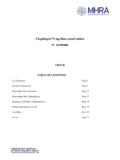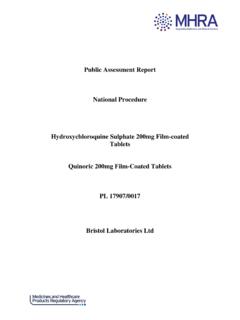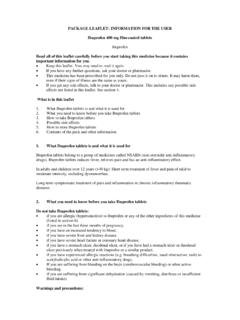Transcription of NEW ZEALAND DATASHEET KEPPRA …
1 KEPPRA tablets and Oral Solution PI g2016-151 Page 1 of 26 NEW ZEALAND DATASHEET KEPPRA (LEVETIRACETAM) FILM-COATED tablets AND ORAL SOLUTION 1 NAME OF THE MEDICINE Levetiracetam 2 QUALITATIVE AND QUANTITATIVE COMPOSITION KEPPRA film-coated tablets are available in strengths of 250 mg, 500 mg, 750 mg and 1000 mg levetiracetam. KEPPRA oral solution is available as 100 mg/mL strength. Levetiracetam is a white to off white powder with a faint odour and a bitter taste. It is very soluble in water (104 g/100 mL). It is freely soluble in chloroform ( g/100 mL) and in methanol ( g/100 mL), soluble in ethanol ( g/100 mL), sparingly soluble in acetonitrile ( g/100 mL) and practically insoluble in n-hexane.
2 KEPPRA oral solution contains the following excipients: Methylhydroxybenzoate, propylhydroxybenzoate, and maltitol solution. For the full list of excipients, see Section List of Excipients. 3 PHARMACEUTICAL FORM KEPPRA film-coated tablets : 250 mg. Blue, oblong, scored film-coated tablet debossed with the code ucb and 250 on one side. 500 mg. Yellow, oblong, scored film-coated tablet debossed with the code ucb and 500 on one side. 750 mg*. Orange, oblong, scored film-coated tablet debossed with the code ucb and 750 on one side. 1000 mg. White, oblong, scored film-coated tablet debossed with the code ucb and 1000 on one side. *not currently distributed in Australia. 4 CLINICAL PARTICULARS THERAPEUTIC INDICATIONS KEPPRA (film-coated tablets and oral solution) is indicated for: use in epileptic patients aged 4 years and older, initially as add-on therapy, in the treatment of partial onset seizures with or without secondary generalisation; monotherapy in the treatment of partial onset seizures, with or without secondary generalisation, in patients from 16 years of age with newly diagnosed epilepsy; add-on therapy in the treatment of myoclonic seizures in adults and adolescents from 12 years of age with juvenile myoclonic epilepsy (JME).
3 And KEPPRA tablets and Oral Solution PI g2016-151 Page 2 of 26 add-on therapy in the treatment of primary generalized tonic-clonic seizures in adults and children from 4 years of age with idiopathic generalized epilepsy (IGE). DOSE AND METHOD OF ADMINISTRATION KEPPRA therapy can be initiated with either intravenous or oral administration. Conversion to or from oral to intravenous can be done directly without titration. The total daily dose and frequency of administration should be maintained. The film-coated tablets must be taken orally, swallowed with liquid. The oral solution may be diluted in a glass of water. Both the film-coated tablets and oral solution may be taken with or without food.
4 After oral administration the bitter taste of levetiracetam may be experienced. The daily dose is administered in two equally divided doses. Monotherapy The recommended starting dose is 250 mg twice daily which should be increased to an initial therapeutic dose of 500 mg twice daily after 2 weeks. The dose can be further increased by 250 mg twice daily every two weeks depending upon the clinical response. The maximum dose is 1500 mg twice daily. Add-on therapy Adults ( 18 years of age) and adolescents (aged 12-17 years of age) weighing 50 kg or more As adjunctive therapy, the therapeutic dose is 500 mg twice daily. This dose can be started on the first day of treatment. Depending upon the clinical response and tolerance, the daily dose can be increased up to 1500 mg twice daily.
5 Dose changes can be made in 500 mg twice daily increments or decrements every 2 to 4 weeks. When satisfactory control of seizures has been attained, monotherapy with KEPPRA may be envisaged by progressively decreasing and withdrawing the concomitant antiepileptic medication. Elderly (65 years and older) Adjustment of the dose is recommended in the elderly with compromised renal function (see Patients with renal impairment below). Children (aged 4 to 11 years of age) and adolescents (aged 12-17 years of age) weighing less than 50 kg The initial therapeutic dose is 10 mg/kg twice daily. See Table 1. Depending on the clinical response and tolerance, the daily dose can be increased up to 60 mg/kg daily (in two 30 mg/kg doses).
6 Dose changes can be made in 10 mg/kg twice daily dose increments or decrements every two weeks. The lowest effective dose should be used. The dosage in children 50 kg or greater is the same as in adults. The physician should prescribe the most appropriate pharmaceutical form and strength according to weight and dose. KEPPRA tablets and Oral Solution PI g2016-151 Page 3 of 26 Table 1. Recommended dosing in children aged 4 years and older Weight Starting dose: 10 mg/kg twice daily Maximum dose: 30 mg/kg twice daily 15 kg (1) 150 mg ( mL) twice daily 450 mg ( mL) twice daily 20 kg (1) 200 mg ( mL) twice daily 600 mg ( mL) twice daily 25 kg 250 mg ( mL) twice daily 750 mg ( mL) twice daily From 50 kg (2) 500 mg ( mL) twice daily 1500 mg (15 mL) twice daily (1) Children 20 kg or less should preferably start the treatment with KEPPRA 100 mg/mL oral solution.
7 (2) Dosage in children and adolescents 50 kg or more is the same as in adults. Infants and children less than 4 years of age There are insufficient data to recommend the use of levetiracetam in children under 4 years of age. Patients with renal impairment The KEPPRA daily dose must be individualised according to renal function. For adult patients, see Table 2 and adjust the dose as indicated. To use this dosing table, an estimate of the patient's creatinine clearance (CLcr) in mL/min is needed. The CLcr in mL/min may be estimated from serum creatinine (micromol/L) determination using the following formula: [140-age(years)] x weight (kg) CLcr = ---------------------------------------- --------- (x for women) x serum creatinine ( mol/L)) Then CLcr is adjusted for body surface area (BSA) as follows: CLcr(mL/ )= CLcr(mL/min) x BSA Subject (m2) Table 2.
8 Adult dosage schedule based on renal function. Group Creatinine clearance (mL/ ) Dosage (mg) Frequency (daily) Normal 80 500 to 1500 Twice Mild 50-79 500 to 1000 Twice Moderate 30-49 250 to 750 Twice Severe < 30 250 to 500 Twice End-stage renal disease patients undergoing dialysis (1) - 500 to 1000 Once (2) (1) A 750 mg loading dose is recommended on the first day of treatment with levetiracetam. (2) Following dialysis, a 250 to 500 mg supplemental dose is recommended. For children with renal impairment, levetiracetam dose needs to be adjusted based on the renal function as levetiracetam clearance is related to renal function. This recommendation is based on a study in adult renally impaired patients. Patients with hepatic impairment No dose adjustment is needed in patients with mild and moderate hepatic impairment.
9 In patients with severe hepatic impairment, the creatinine clearance may underestimate the renal KEPPRA tablets and Oral Solution PI g2016-151 Page 4 of 26 insufficiency. Therefore a 50% reduction of the daily maintenance dose is recommended when the creatinine clearance is < 60 mL/ m2. CONTRAINDICATIONS Hypersensitivity to levetiracetam or other pyrrolidone derivatives or any of the excipients (see Section List of Excipents). SPECIAL WARNINGS AND PRECAUTIONS FOR USE In accordance with current clinical practice, if KEPPRA has to be discontinued it is recommended to withdraw it gradually. Amongst its excipients, KEPPRA oral solution includes methylhydroxybenzoate and propylhydroxybenzoate which may cause allergic reactions (possibly delayed) and maltitol which may have a mild laxative effect.
10 KEPPRA oral solution also contains glycerol which can cause headache, stomach upset and diarrhoea when ingested in doses greater than 10 g. Please note, however, that the glycerol content is less than g in a recommended KEPPRA dose in children weighing 20 kg or less. Patients with rare hereditary problems of fructose intolerance should not take the oral solution. Due to its complete and linear absorption, plasma levels can be predicted from the oral dose of levetiracetam expressed as mg/kg bodyweight. There is no need therefore for plasma level monitoring of levetiracetam. No data on the interaction of levetiracetam with alcohol are available. Suicidal behaviour and ideation Antiepileptic drugs, including levetiracetam, increase the risk of suicidal thoughts or behaviour in patients taking these drugs for any indication.














